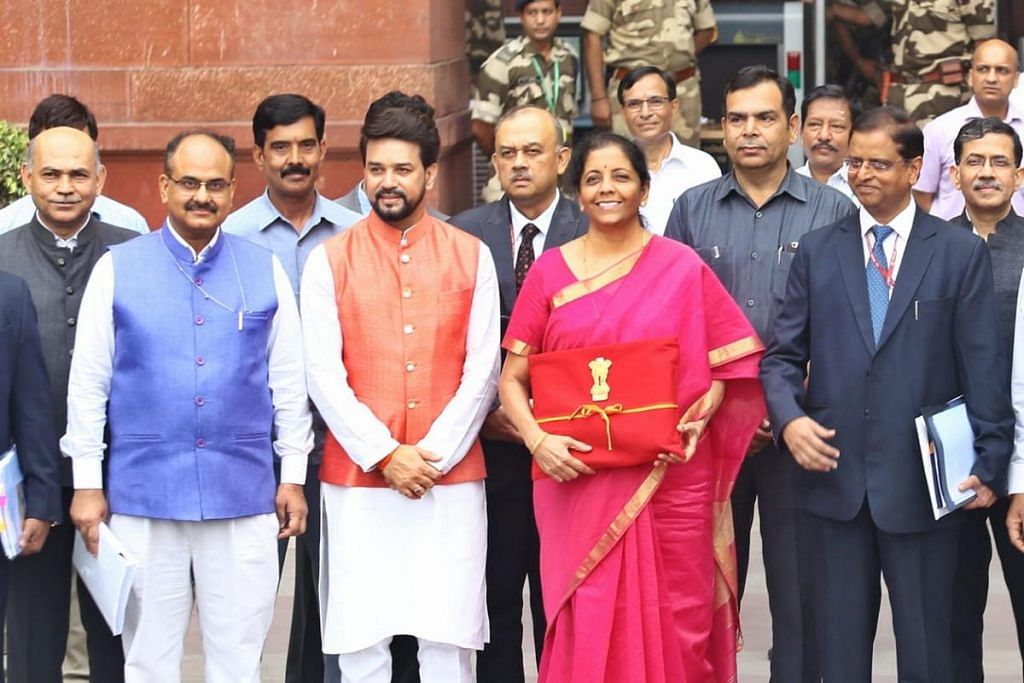New Delhi: In her first Union Budget, Finance Minister Nirmala Sitharaman Friday chose to boost growth through a push to domestic and foreign investment and a massive infrastructure thrust as the Modi government looked to retain India’s ‘fastest growing economy’ tag.
Trying not to hamper the government’s various welfare schemes while pushing for growth, the finance minister also announced a series of steps to secure greater revenue from tax and duties.
The moves came even as the government stated the Budget’s aim to make India a $5-trillion economy by 2024-25 — even at a time when the economy has slowed down considerably, with a 5-year low of 5.8 per cent seen in the quarter ended March.
However, the stock markets were not enthused by the Budget proposals and closed in the red.
Industry is the new friend: Encouraging domestic investment
During her Budget speech, Sitharaman acknowledged the crucial role played by industry and called them wealth and job creators.
Stressing the need to work together, she said, “Together, with mutual trust, we can gain, catalyze fast and attain sustained national growth.”
The Budget laid down many sops for industry including a lower tax rate of 25 per cent for firms with a turnover of up to Rs 400 crore, effectively bringing more than 99 per cent of the firms under the new rate. The earlier turnover limit for availing the lower tax rate was Rs 250 crore.
For micro, small and medium enterprises (MSMEs), Sitharaman proposed a mechanism to eliminate delays in government payments to suppliers and contractors, especially to SMEs and MSMEs to free up cash flows.
Also read: Sensex declines as Nirmala Sitharaman’s budget spooks investors
Steps to increase foreign investment
The Budget presented a slew of measures to attract foreign investments into the country including relaxation in foreign direct investment (FDI) caps in sectors like aviation, media, animation and insurance sector.
It also promised an easing of local sourcing norms in single brand retail sector while increasing FDI in insurance intermediaries to 100%.
The measures come at a time FDI slips into India contracted for the first time in 2018-19 to $44.37 billion from $44.85 billion in the previous fiscal.
Sitharaman also announced a relaxation in foreign portfolio investment (FPI) cap in the secondary market. At present, foreign portfolio investors cannot hold more than 24 per cent in a company. However, the finance minister suggested removing the cap and increasing it to the sectoral foreign investment limits. However, the companies will have an option to lower the threshold for FPI holding in their firm.
The Budget also proposed rationalising the existing ‘Know Your Customer’ norms for FPIs to make it more investor-friendly. She also said that India will host an annual global investor meet with the National Infrastructure and Investment Fund acting as an anchor.
The government is hoping that these steps will help in reviving growth that slowed down for the second consecutive year to 6.8 per cent in 2018-19 from 7.2 per cent in 2017-18 and 8.2 per cent in 2016-17.
Massive infrastructure push
Sitharaman also proposed that India should enter the aircraft financing and leasing activities from Indian shores. She sought to provide an enabling ecosystem for growth of maintenance, repair and overhaul (MRO) industry.
Further, the finance minister pushed for a revamp of the financing model for national highways, apart from greater public private participation for railway infrastructure and a package of power sector tariff and structural reforms.
A lower fiscal deficit: Where is the money coming from?
Surprising many, Sitharaman lowered the fiscal deficit projections to 3.3 per cent of gross domestic product from the 3.4 per cent projected in the interim budget.
To ensure the fiscal discipline, the Budget proposed an increase in surcharge for those earning more than Rs 2 crore of taxable income annually.
The effective increase in tax rates for the two groups of high net worth individuals — between Rs 2 crore and Rs 5 crore and above Rs 5 crore — will come to 3 per cent and 7 per cent, respectively.
Sitharaman also announced an increase in both the additional excise duty and the cess on petrol and diesel each by Re 1 per litre each, a move that is likely to make fuel more expensive for the common man.
The Modi government also expects the Reserve Bank of India (RBI) to come to its rescue. It has budgeted Rs 1.06 lakh crore to come as dividends/surplus from RBI and other financial institutions in 2019-20 as against Rs 74,140 crore in 2018-19.
The government also set an aggressive disinvestment target of Rs 1.05 lakh crore and will look at strategic stake sales.
Intervening to prevent a NBFC crisis
Sitharaman also looked to address fears of an impending financial sector crisis triggered by the IL&FS default by arming RBI with more powers to regulate NBFCs and providing credit guarantee to state-run banks to nudge them to acquire NBFCs’ assets.
Under the credit guarantee scheme the finance minister announced, purchase of high rated pool assets of financially sound NBFCs by these banks will be guaranteed to accommodate up to 10 per cent of the first loss incurred by these banks.
Also read: What is Zero-budget farming – Nirmala Sitharaman’s fix to double farm income
